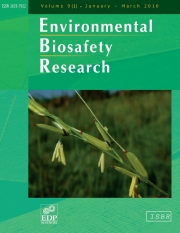Crossref Citations
This article has been cited by the following publications. This list is generated based on data provided by
Crossref.
Andow, D. A.
2003.
Editorial: Negative and positive data, statistical power, and confidence intervals.
Environmental Biosafety Research,
Vol. 2,
Issue. 2,
p.
75.
ANDOW, DAVID A.
and
HILBECK, ANGELIKA
2004.
Science-Based Risk Assessment for Nontarget Effects of Transgenic Crops.
BioScience,
Vol. 54,
Issue. 7,
p.
637.
Romeis, Jörg
Sharma, Hari C
Sharma, Kiran K
Das, Sampa
and
Sarmah, Bidyut K
2004.
The potential of transgenic chickpeas for pest control and possible effects on non-target arthropods.
Crop Protection,
Vol. 23,
Issue. 10,
p.
923.
Sanvido, Olivier
Widmer, Franco
Winzeler, Michael
and
Bigler, Franz
2005.
A conceptual framework for the design of environmental post-market monitoring of genetically modified plants.
Environmental Biosafety Research,
Vol. 4,
Issue. 1,
p.
13.
Lövei, G.L.
and
Arpaia, S.
2005.
The impact of transgenic plants on natural enemies: a critical review of laboratory studies.
Entomologia Experimentalis et Applicata,
Vol. 114,
Issue. 1,
p.
1.
Raybould, Alan
2005.
Crop Ferality and Volunteerism.
p.
389.
HILL, Ryan A.
2005.
Conceptualizing risk assessment methodology for genetically modified organisms.
Environmental Biosafety Research,
Vol. 4,
Issue. 2,
p.
67.
Raybould, Alan
and
Cooper, Ian
2005.
Tiered tests to assess the environmental risk of fitness changes in hybrids between transgenic crops and wild relatives: the example of virus resistantBrassica napus.
Environmental Biosafety Research,
Vol. 4,
Issue. 3,
p.
127.
Raybould, Alan
and
Wilkinson, Michael J.
2005.
Gene Flow from GM Plants.
p.
169.
Romeis, Jörg
Meissle, Michael
and
Bigler, Franz
2006.
Transgenic crops expressing Bacillus thuringiensis toxins and biological control.
Nature Biotechnology,
Vol. 24,
Issue. 1,
p.
63.
Romeis, Jörg
Meissle, Michael
and
Bigler, Franz
2006.
Reply to Ecological risk assessment for Bt crops.
Nature Biotechnology,
Vol. 24,
Issue. 7,
p.
751.
Andow, D. A.
and
Zwahlen, Claudia
2006.
Assessing environmental risks of transgenic plants.
Ecology Letters,
Vol. 9,
Issue. 2,
p.
196.
Harwood, J. D.
and
Obrycki, J. J.
2006.
The detection and decay of Cry1Ab Bt-endotoxins within non-target slugs,Deroceras reticulatum(Mollusca: Pulmonata), following consumption of transgenic corn.
Biocontrol Science and Technology,
Vol. 16,
Issue. 1,
p.
77.
Devos, Yann
Reheul, Dirk
De Waele, Danny
and
Van Speybroeck, Linda
2006.
The interplay between societal concerns and the regulatory frame on GM crops in the European Union.
Environmental Biosafety Research,
Vol. 5,
Issue. 3,
p.
127.
Raybould, Alan
2006.
Problem formulation and hypothesis testing for environmental risk assessments of genetically modified crops.
Environmental Biosafety Research,
Vol. 5,
Issue. 3,
p.
119.
HILL, RYAN
and
SENDASHONGA, CYRIE
2006.
Conservation Biology, Genetically Modified Organisms, and the Biosafety Protocol.
Conservation Biology,
Vol. 20,
Issue. 6,
p.
1620.
Cooper, Ian
and
Jones, Roger A.C.
2006.
Plant Virus Epidemiology.
Vol. 67,
Issue. ,
p.
1.
Raybould, Alan
2007.
Ecological versus ecotoxicological methods for assessing the environmental risks of transgenic crops.
Plant Science,
Vol. 173,
Issue. 6,
p.
589.
Popelka, J. C.
and
Higgins, T. J. V.
2007.
Transgenic Crops IV.
Vol. 59,
Issue. ,
p.
251.
2007.
Reply to Early-tier tests insufficient for GMO risk assessment.
Nature Biotechnology,
Vol. 25,
Issue. 1,
p.
36.

